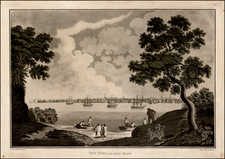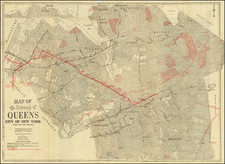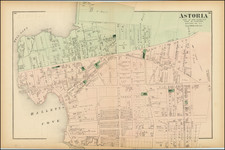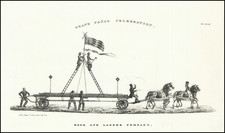Attractive 19th-Century Manuscript Map of Kip's Bay, New York City
A fine manuscript cadastral survey map showing a substantial area just north of the modern-day Manhattan neighborhood of Kip's Bay. The area shown is bounded by 42nd Street to the north, 38th Street to the south, Third Avenue to the west, and the East River to the west.
The map relates to the process by which early farms and estates were subdivided as the famed Manhattan grid overtook the island in the middle of the 19th century. This process resulted in much reflection by historians, surveyors, and lawyers, as they attempted to make sense of the complex changes in ownership and title that had occurred over the prior decades. Particularly in the 1860s and '70s there was much work done on mapping historical ownership by the likes of John Bute Holmes. This map is redolent of his printed maps but is entirely manuscript.
The original survey on which the present map is based was made by Edwin Smith, New York City Surveyor, in the 1830s. The map bears a handwritten note in red ink, styling itself as a "Copy - Decr.- 1869." It would seem that the present map was copied in 1869, based on an 1830s original by Edwin Smith. Smith lived until 1871. The text below the fine and boldly delineated hand-lettered caption title, cites an 1833 case in chancery court involving Samuel K. Kip and other defendants, as follows:
In Chancery: Before the vice Chancellor of the 1st: Circuit vs. Samuel K. Kip and other, Defendants.
We Thomas Bolton, Murray Hoffman and Geo. B. Smith, Commissioners appointed in and by a decretal order made in the above entitled case on the 26th day of April 1833 to make partition of the Land's tenements and hereditaments in the pendings and proceedings in the said cause mentioned and described among and between the parties interested in and entitled unto the same, by virtue of the said decretal order, Dated this 23. day of May 1833.
Thomas Bolton
Murray Hoffman
George B. Smith,
Commissioners
This land partition case involved a fairly large number of property owners (see below), along a diagonal swath through this portion of Manhattan. Indeed, the list of names, here transcribed from the map's color-coded key, identifies a who's who of prominent landowners within this piece of prime New York City real estate, including several members of the Kip family.
Henry Kip
John Y. Van Tuyl & Catherine his wife
Samuel K. Kip
Theo. S. Gold & Ann Louisa Gold his wife
Mary Walker Kip
Elizabeth Kip daughter of James Kip Dec:d
James B. Mower and Mary his wife
Unknown Owners & Mary Mower
Samuel E. Kip
Elizabeth Kip daughter of Elbert Kip Dec:d
Gardiner Kip
Anna Kip
Maria Kip Widow of Elbert Kip Dec:d
Samuel Jones
Wm. Richardson & Margaret his wife
Charles S. Kip
Jacob Oliver & Maria his wife
Elizabeth Kip & daughter of Cornelius Kip
Cornelius Kip
Mary Ann Kip
James H. Kip
Elbert S. Kip
Samuel Kip, Jr:
Henry Kip, son of Samuel Kip, lately Dec:d
George Washington Kip
The Kip Family in New York City
The Kips were a distinguished family of early settlers in New Netherlands who arrived before the settlement changed its name to New York. Jacob A. Kip, an early New York resident, was a direct ancestor of Henrick Hendricksen Kip of Holland, who emigrated to America in the 1630s, settling in Fort Amsterdam, New Netherlands. The Kip family owned property in Kip's Bay, now a neighborhood on the east side of Manhattan, comprising the area east of Third Avenue between East 34th and 27th Streets. Before being reclaimed land, the area was an inlet of the East River. The place was named for the New Netherland Dutch settler Jacobus Hendrickson Kip (1631-1690), son of Hendrick Henricksen Kip, who owned a farm along the East River approximately where 30th Street is today. The Kip house, a large brick and stone structure located near the present-day intersection of Second Avenue and East 35th Street, stood from 1655 to 1851 and was purportedly the last of the original New Amsterdam farmhouses in Manhattan to be demolished. Kips Bay was also the location of action during the New York and New Jersey campaign of the American Revolution. About 4000 British troops under General William Howe landed at Kips Bay on September 15, 1776. The British forces defeated about 500 American militiamen stationed there by George Washington and who were under the command of Colonel William Douglas. The British occupation of the town of New York forced Washington to retreat north to the Harlem River.
According to a history of the Kip family:
Of the twelve children of Jacobus I., Samuel I. (1682) became the owner of the estate and was succeeded by Jacobus (Jacob) Kip II, born in Kip's Bay, 1706. Kip was an old man when the American Revolution broke out and was too feeble to take up arms for the cause of freedom. Too ill to be moved, he remained in his house, which stood overlooking the East River, near where is now the Thirty-fourth Street Ferry. In spite of the danger, he stayed manfully at his post, and was in the house the day the British fleet opened fire upon the American earthworks, situated upon the bluff near his home. During the bombardment, he and his family took refuge in the cellar, and so escaped injury. Promptly after landing, the British troops occupied the mansion, but their commander set aside a portion, including three large rooms, for the head of the house and his two beautiful daughters. The shock, however, was too much for Jacobus, who died before the close of the war.
An eminently displayable and beautifully drawn survey map of an historically interesting part of Manhattan.
Smith was appointed City Surveyor in New York City in 1831. A prolific land surveyor who worked during an important time in the development of New York City real estate (the early to mid-19th-century), Smith's work ranges from commercial commissions to official work as City Surveyor. Most of his work (largely original manuscript maps) resides within institutional confines, including New York Historical Society and various New York City archives.













![Southeastern New York [with inset] Vicinity of New York](https://storage.googleapis.com/raremaps/img/small/101125.jpg)
